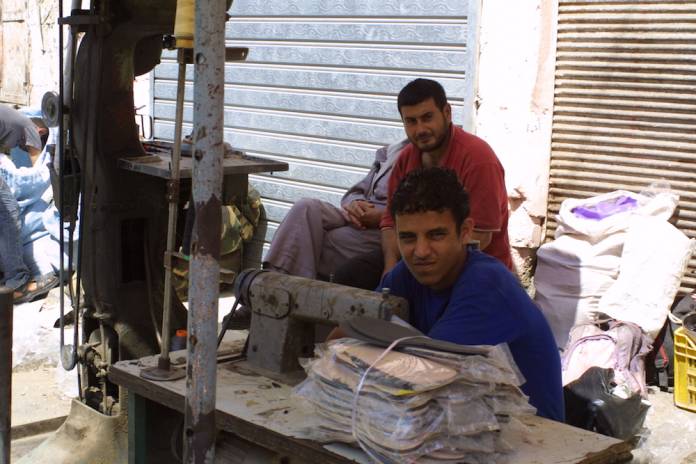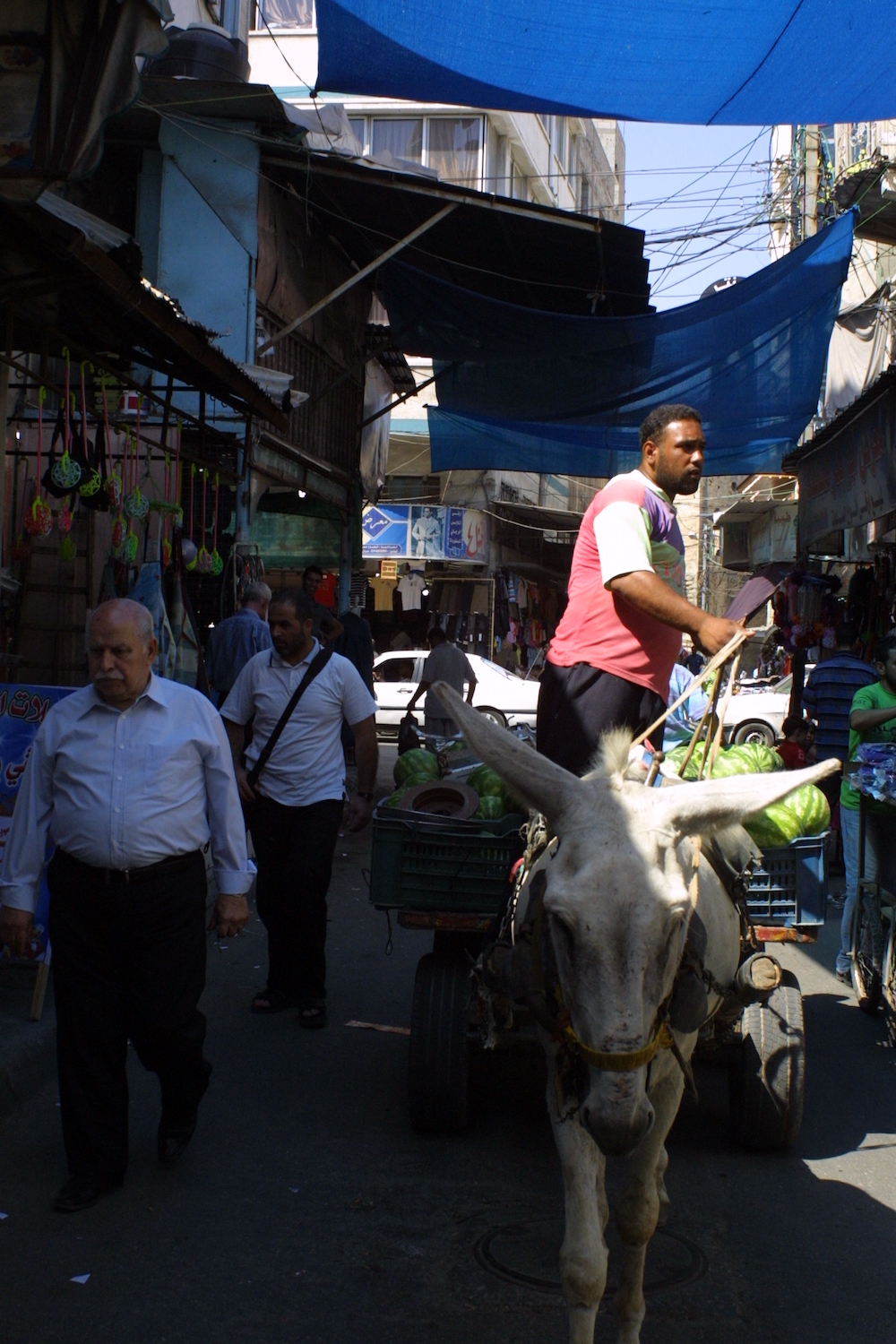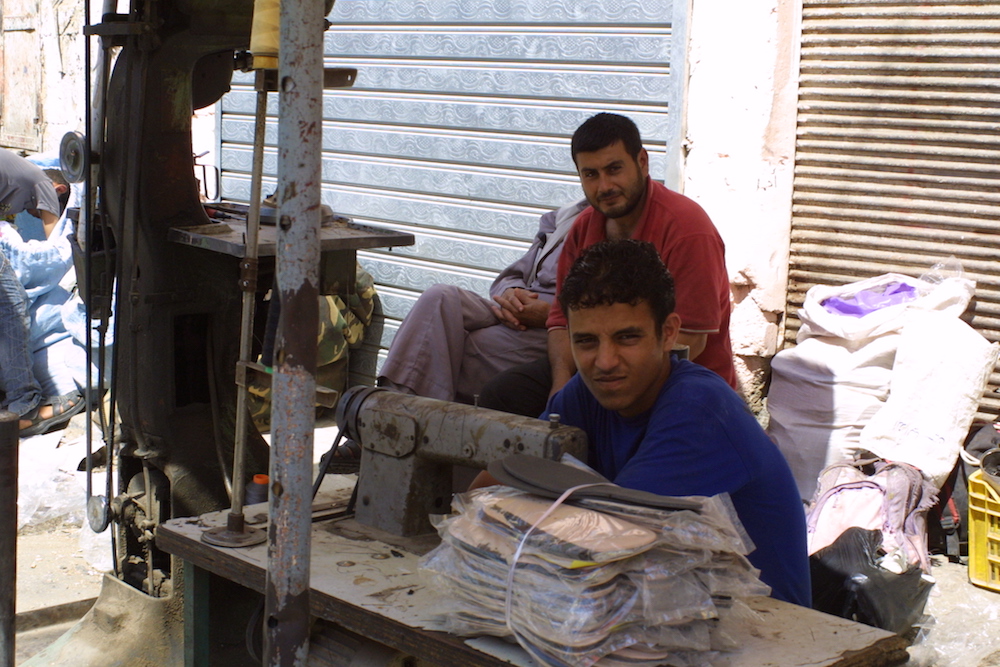
On my most recent reporting trip to Gaza, I stayed with a family living just a short walk from the Israeli border. At dusk we could see a beautiful sunset over the Mediterranean and forget the ongoing conflict for just a few minutes.
Living conditions for the family have gotten much worse since my visit. They have electricity four hours a day, medicine is in short supply, and they have to get all their water delivered by truck. Overall unemployment in Gaza is 27% with youth unemployment at a staggering 60%, according to the World Bank.

Photo by Reese Erlich
That high unemployment presents the biggest problem, said family member Jihad Mosalami, a university English professor. “People can’t survive,” he told me in a phone interview.
Many of Mosalami’s students were among the tens of thousands who demonstrated at the fence separating Gaza and Israel. “A few went to the fence to throw stones,” he said. “Others went to the fence to pray.”
It didn’t matter to Israel Defense Forces (IDF) soldiers if the demonstrators were peaceful or not. They shot tear gas and live ammunition.
“It was like hell,” said Mosalami.
From March 30 to May 15, Israeli security forces killed over 100 Palestinians and wounded more than 10,000, according to the Palestinian health officials. No Israeli soldiers were killed or even seriously injured.
Palestinians organized the “Great March of Return,” to protest the Israeli military blockade of Gaza. Israeli soldiers control all food, medicine, building supplies and other goods that enter or exit Gaza. The IDF frequently holds up essential goods to pressure Hamas, which rules the Palestinian enclave.
Help us save local journalism!
Every tax-deductible donation helps us grow to cover the issues that mean the most to our community. Become a 48 Hills Hero and support the only daily progressive news source in the Bay Area.

Israeli authorities claimed they were protecting their border from hordes of Palestinians, some armed, intent on crashing through the fence. In reality, no one got though the double fence and large no man’s land created by Israel. The IDF shot civilians to intimidate them–not out of self defense.
But IDF tactics backfired. Palestinians won the political battle by gaining renewed sympathy for their struggle around the world.
The young generation of Palestinians discovered they “can make a difference, not least of which in bringing global attention to their cause,” Brian Barber told me. He’s professor emeritus at the University of Tennessee and senior fellow at the Institute for Palestine Studies in Washington DC. The protests gave young Palestinians “their first taste of vibrant collective action … as their parents had with the first intifada.”
Why would young people risk their lives to protest the occupation? Let’s take a look at some of the underlying political issues.
What’s the Right of Return?
Sixty-eight percent of people living in Gaza are registered with the UN as refugees who were expelled from Israel in 1948 or their descendants. I’ve interviewed Palestinians who still have the keys to their 1948 houses. Under international law these refugees have the right to return to their towns and villages, according to James Zogby, president of the Arab American Institute.
There are 5 million Palestinians worldwide. As a practical matter, many would not want to return to Israel. Their homes and villages may no longer exist. And many Palestinians “don’t want to live as a minority in Israel,” Zogby told me.
If Israel recognizes a fully independent, viable, and contiguous Palestinian state, many refugees would return there. Years ago the Palestine Liberation Organization proposed that a limited number of Palestinians should be allowed to return to their villages in Israel while the vast majority would have the right to return to the newly independent Palestinian state.
But Palestinians won’t make any compromises on such a critical issue except in the context of an overall peace settlement. And as of press time, neither the United States nor Israel have shown any interest in peace talks.
One State or Two?
For many years the left and progressives supported the concept of one state in which all Palestinians would be free to return to Israel as equal citizens. The democratic state would champion one person, one vote with no discrimination based on ethnicity or religion.
Eighty-one percent of Israeli Jews reject a one-state solution, according to a 2017 poll, because the return of millions of Palestinians would eliminate Israel as a Jewish state. The one state plan has little support even among progressive Israelis opposed to the occupation of the West Bank and Gaza.
By the 1980s, the PLO began to propose a two-state solution in which the Palestinians and Israelis would have their own states living in peace. Negotiations would determine borders based on Israel’s pre-1967 territory. Different parts of Jerusalem could serve as capitals of both countries. The two state solution served as the basis for the 1993 Oslo peace accord.
Successive Israeli governments never implemented the Oslo agreement, however. They continued to build Israeli settlements in the West Bank, and unilaterally built a wall dividing Israel and the West Bank that doesn’t follow the 1967 border line.
In March a Palestinian poll showed 48% of Palestinians in the West Bank and Gaza supported two states and 50% opposed. But only 28% supported one state.
“I’m not an activist or politician,” said my friend Mosalami, “but I do believe the majority of Palestinians will accept two states. It’s the practical solution.”
But doesn’t Hamas reject two states?
Actually, Hamas is willing to accept the two-state solution. Soon after Hamas won the 2006 Palestinian Authority parliamentary elections, its leaders faced reality. Having one state was not possible and most Palestinians favored two states.
“We accepted that our state should be on the 1967 borders, but Israel rejected that,” then top Hamas leader Khaled Meshal told me. He confirmed that position with former President Jimmy Carter. I re-confirmed that view with two different Hamas ministers during a 2011 trip to Gaza.
Hamas doesn’t emphasize that position because there are no peace talks on the horizon. Hamas leaders want Israel or the United States to put forward a viable two-state option, and then it will respond.
But isn’t Hamas a terrorist organization? How could Israel trust them in negotiations?
Hamas is a political party with an armed militia that functions as Gaza’s security force. It considers itself a national liberation movement fighting occupation forces through armed struggle. But Hamas has also intentionally killed civilians, including bombing buses and restaurants. Using terrorist tactics, however, doesn’t make one a terrorist organization.
Jewish militias fighting the British and Arabs in 1948-49 used terrorist tactics. They murdered and tortured Arabs in the village of Deir Yassin, forcing residents to flee. They blew up the KIng David Hotel, killing more than 90 Jews, Arabs, and British soldiers.
Some of the Jewish militia tactics parallel recent events in Gaza. Yuri Avnery, today one of the Israel’s major peace movement leaders, described how he participated in a 1948 Tel Aviv march organized by the Irgun, a militia later incorporated into the IDF.
Civilian Irgun youth marched down a street “where the offices of the British administration were located,” Avnery wrote. “There we sang the national anthem, ‘Hatikvah’, while some adult members set fire to the offices.”
I oppose the use of terrorism whatever the justification. But Hamas is fundamentally different from Al Qaeda or the Islamic State, who use terror to ethnically cleanse groups they oppose–Christians, Jews, Shia Muslims, and others. They refuse to participate in elections and use religion as the excuse to give themselves absolute power.
Hamas promotes a conservative religious agenda but is not the Islamic State. I would not vote for Hamas if I lived in Palestine. But Hamas is a legitimate party whose views are part of the Middle East political reality.
Labeling Hamas a terrorist organization gives Israel and the United States an excuse to never hold peace talks. The Israeli government labelled he Palestine Liberation Organization terrorists until Israel agreed to the Oslo peace talks. Then the PLO became peace partners.
Earlier this month Hamas offered Israel a “hudna” or ceasefire. Hamas sources told the website Al Monitor if Israel lifted the siege of Gaza, Hamas would enter negotiations with Israel for a long term ceasefire.
Should Israeli leaders trust Hamas? No. And Palestinian leaders shouldn’t trust the Israeli government. But there is a common need to begin serious discussions to establish a viable Palestinian state. Each side can advance partial measures and verify their implementation before moving ahead.
My Gaza friend Jihad Mosalami said, “They have to negotiate and reach a deal. People in Gaza want a decent life.”
He acknowledged that the current leadership in Washington and Tel Aviv won’t start talks anytime soon.
“We won’t have war forever,” he said with just a hint of optimism. “The war will end and there can be peace.”
On my most recent reporting trip to Gaza, I stayed with a family living just a short walk from the Israeli border. At dusk we could see a beautiful sunset over the Mediterranean and forget the ongoing conflict for just a few minutes.
Living conditions for the family have gotten much worse since my visit. They have electricity four hours a day, medicine is in short supply, and they have to get all their water delivered by truck. Overall unemployment in Gaza is 27% with youth unemployment at a staggering 60%, according to the World Bank.
That high unemployment presents the biggest problem, said family member Jihad Mosalami, a university English professor. “People can’t survive,” he told me in a phone interview.
Many of Mosalami’s students were among the tens of thousands who demonstrated at the fence separating Gaza and Israel. “A few went to the fence to throw stones,” he said. “Others went to the fence to pray.”
It didn’t matter to Israel Defense Forces (IDF) soldiers if the demonstrators were peaceful or not. They shot tear gas and live ammunition.
“It was like hell,” said Mosalami.
From March 30 to May 15, Israeli security forceskilled over 100 Palestiniansand wounded more than 10,000, according to the Palestinian health officials. No Israeli soldiers were killed or even seriously injured.
Palestinians organized the “Great March of Return,” to protest the Israeli military blockade of Gaza. Israeli soldiers control all food, medicine, building supplies and other goods that enter or exit Gaza. The IDF frequently holds up essential goods to pressure Hamas, which rules the Palestinian enclave.
Israeli authorities claimed they were protecting their border from hordes of Palestinians, some armed, intent on crashing through the fence. In reality, no one got though the double fence and large no man’s land created by Israel. The IDF shot civilians to intimidate them–not out of self defense.
But IDF tactics backfired. Palestinians won the political battle by gaining renewed sympathy for their struggle around the world.
The young generation of Palestinians discovered they “can make a difference, not least of which in bringing global attention to their cause,” Brian Barber told me. He’s professor emeritus at the University of Tennessee and senior fellow at the Institute for Palestine Studiesin Washington DC. The protests gave young Palestinians “their first taste of vibrant collective action … as their parents had with the first intifada.”
Why would young people risk their lives to protest the occupation? Let’s take a look at some of the underlying political issues.
What’s the Right of Return?
Sixty-eight percent of people living in Gaza areregistered with the UNas refugees who were expelled from Israel in 1948 or their descendants. I’ve interviewed Palestinians who still have the keys to their 1948 houses. Under international law these refugees have the right to return to their towns and villages, according to James Zogby, president of the Arab American Institute.
There are 5 million Palestinians worldwide. As a practical matter, many would not want to return to Israel. Their homes and villages may no longer exist. And many Palestinians “don’t want to live as a minority in Israel,” Zogby told me.
If Israel recognizes a fully independent, viable, and contiguous Palestinian state, many refugees would return there. Years ago the Palestine Liberation Organization proposed that a limited number of Palestinians should be allowed to return to their villages in Israel while the vast majority would have the right to return to the newly independent Palestinian state.
But Palestinians won’t make any compromises on such a critical issue except in the context of an overall peace settlement. And as of press time, neither the United States nor Israel have shown any interest in peace talks.
One State or Two?
For many years the left and progressives supported the concept of one state in which all Palestinians would be free to return to Israel as equal citizens. The democratic state would champion one person, one vote with no discrimination based on ethnicity or religion.
Eighty-one percent of Israeli Jews reject a one-state solution, according to a 2017 poll, because the return of millions of Palestinians would eliminate Israel as a Jewish state. The one state plan has little support even among progressive Israelis opposed to the occupation of the West Bank and Gaza.
By the 1980s, the PLO began to propose a two-state solution in which the Palestinians and Israelis would have their own states living in peace. Negotiations would determine borders based on Israel’s pre-1967 territory. Different parts of Jerusalem could serve as capitals of both countries. The two state solution served as the basis for the 1993 Oslo peace accord.
Successive Israeli governments never implemented the Oslo agreement, however. They continued to build Israeli settlements in the West Bank, and unilaterally built a wall dividing Israel and the West Bank that doesn’t follow the 1967 border line.
In March a Palestinian pollshowed 48% of Palestinians in the West Bank and Gaza supported two states and 50% opposed. But only 28% supported one state.
“I’m not an activist or politician,” said my friend Mosalami, “but I do believe the majority of Palestinians will accept two states. It’s the practical solution.”
But doesn’t Hamas reject two states?
Actually, Hamas is willing to accept the two-state solution. Soon after Hamas won the 2006 Palestinian Authority parliamentary elections, its leaders faced reality. Having one state was not possible and most Palestinians favored two states.
“We accepted that our state should be on the 1967 borders, but Israel rejected that,” then top Hamas leader Khaled Meshal told me. He confirmed that position with former President Jimmy Carter. I re-confirmed that view with two different Hamas ministers during a 2011 trip to Gaza.
Hamas doesn’t emphasize that position because there are no peace talks on the horizon. Hamas leaders want Israel or the United States to put forward a viable two-state option, and then it will respond.
But isn’t Hamas a terrorist organization? How could Israel trust them in negotiations?
Hamas is a political party with an armed militia that functions as Gaza’s security force. It considers itself a national liberation movement fighting occupation forces through armed struggle. But Hamas has also intentionally killed civilians, including bombing buses and restaurants. Using terrorist tactics, however, doesn’t make one a terrorist organization.
Jewish militias fighting the British and Arabs in 1948-49 used terrorist tactics. They murdered and tortured Arabs in the village of Deir Yassin, forcing residents to flee. They blew up the KIng David Hotel, killing more than 90 Jews, Arabs, and British soldiers.
Some of the Jewish militia tactics parallel recent events in Gaza. Yuri Avnery, today one of the Israel’s major peace movement leaders, described how he participated in a 1948 Tel Aviv march organized by the Irgun, a militia later incorporated into the IDF.
Civilian Irgun youth marched down a street “where the offices of the British administration were located,” Avnery wrote. “There we sang the national anthem, ‘Hatikvah’, while some adult members set fire to the offices.
I oppose the use of terrorism whatever the justification. But Hamas is fundamentally different from Al Qaeda or the Islamic State, who use terror to ethnically cleanse groups they oppose–Christians, Jews, Shia Muslims, and others. They refuse to participate in elections and use religion as the excuse to give themselves absolute power.
Hamas promotes a conservative religious agenda but is not the Islamic State. I would not vote for Hamas if I lived in Palestine. But Hamas is a legitimate party whose views are part of the Middle East political reality.
Labeling Hamas a terrorist organization gives Israel and the United States an excuse to never hold peace talks. The Israeli government labelled he Palestine Liberation Organization terrorists until Israel agreed to the Oslo peace talks. Then the PLO became peace partners.
Earlier this month Hamas offered Israel a “hudna” or ceasefire. Hamas sources told the website Al Monitor if Israel lifted the siege of Gaza, Hamas would enter negotiations with Israel for a long term ceasefire.
Should Israeli leaders trust Hamas? No. And Palestinian leaders shouldn’t trust the Israeli government. But there is a common need to begin serious discussions to establish a viable Palestinian state. Each side can advance partial measures and verify their implementation before moving ahead.
My Gaza friend Jihad Mosalami said, “They have to negotiate and reach a deal. People in Gaza want a decent life.”
He acknowledged that the current leadership in Washington and Tel Aviv won’t start talks anytime soon.
“We won’t have war forever,” he said with just a hint of optimism. “The war will end and there can be peace.”
Reese Erlich’s syndicated column, Foreign Correspondent, appears every two weeks. He has reported on the Israel-Palestine conflict since 1986. Follow him on Twitter, @ReeseErlich; friend him on Facebook; and visit his webpage.
